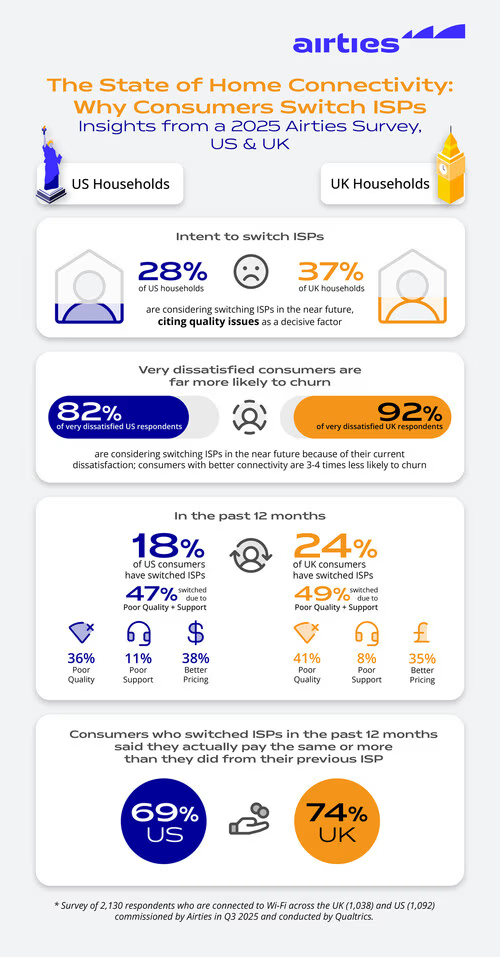
One-Third of US & UK Consumers Plan to Switch ISPs, Airties Survey Finds
In the run-up to the 2025 Network X conference in Paris, Airties has released new consumer research that will make Internet Service Providers (ISPs) sit up straight. The Istanbul-headquartered company, known globally for its AI-driven software that powers smarter, more reliable home Wi-Fi, commissioned Qualtrics to survey over 2,000 households in the US and UK.
The results are striking: nearly one-third of households say they are considering switching ISPs in the near future—and service quality, not price, is driving that decision.
For ISPs battling against ever-rising customer acquisition costs and razor-thin margins, the implications are serious. Let’s unpack the findings, the pain points for consumers, and what this churn crisis could mean for the industry.
The Churn Problem: Quality, Not Cost, at the Core
According to the survey, 37% of UK respondents and 28% of US respondents are actively considering a switch. Among them, poor Internet quality was cited as the top reason—by 31% in the UK and a striking 42% in the US.
And what does “poor quality” actually mean in daily life? Respondents point to issues such as:
- Slow browsing (55% UK; 50% US)
- Video freezing (52% UK; 55% US)
- Devices disconnecting (49% UK; 58% US)
These are the types of frustrations that derail Netflix binges, work Zoom calls, and even Wi-Fi-enabled home security cameras. In other words, the failures are not abstract—they cut into the daily rhythm of households.
Dissatisfaction Turns Into Action
The survey highlights a worrying churn trajectory:
- 24% of UK consumers and 18% of US consumers already switched ISPs in the last 12 months.
- Many waited months before leaving, usually until contracts expired—showing how frustration lingers before breaking point.
- Nearly all complained to their ISP first (88% UK; 85% US) before taking the nuclear option of switching.
And here’s the killer stat: 92% of UK and 82% of US respondents who say they are “very dissatisfied” are considering leaving their ISP soon. That’s not a vague threat; that’s an almost guaranteed churn pipeline.
 Wi-Fi Quality and Support Trump Price
Wi-Fi Quality and Support Trump Price
It’s tempting for ISPs to think that price wars are their best weapon. But Airties’ data contradicts that.
- 79% of UK and 74% of US respondents report experiencing Wi-Fi problems today.
- When asked what drove them to switch, quality of experience (QoE) and customer support together outweighed price.
- In both countries, more than 70% of consumers said they would not switch to a cheaper ISP if it meant worse Wi-Fi.
This flips the long-standing industry assumption that “lower price equals higher retention.” Instead, consumers are showing a willingness to pay more—as long as it comes with reliable, consistent connectivity.
Streaming, Gaming, and the New Wi-Fi Demands
The survey also sheds light on how households are using connectivity today:
- In the UK, video streaming and Wi-Fi calling are top priorities.
- In the US, video streaming and online gaming dominate.
That’s a subtle but important difference. Gamers, especially, are notoriously unforgiving of lag and latency issues, which can quickly sour an ISP’s reputation.
Consumers also want smarter control. 75% of UK and 56% of US respondents said they’d value the ability to prioritize bandwidth—say, giving Zoom calls more stability during working hours while de-prioritizing YouTube or gaming in the background.
And more than half of consumers on both sides of the Atlantic are interested in a Wi-Fi system that automatically predicts and prioritizes usage. This is exactly where AI-driven solutions like Airties Home come into play.
Why This Matters for ISPs’ Bottom Lines
Metin Taskin, Airties’ CEO and founder, put it bluntly:
“It’s a multi-billion-dollar problem for broadband service providers globally. With such high churn rates, ISPs are forced to spend incredible time and money chasing new customers every year—just to break even for the customers they lost.”
Taskin’s point echoes what analysts at Analysys Mason and PwC have long argued: cutting churn by even a few percentage points can drive disproportionate profitability. Acquisition costs for new broadband subscribers are soaring, and retention is becoming the smarter—and cheaper—growth lever.
Where Airties Fits In
Airties positions itself as a solution provider rather than just another vendor. Its AI-driven software suite helps ISPs manage in-home connectivity in real time:
- Steering devices to the best Wi-Fi access point or band.
- Managing mesh networks.
- Diagnosing and fixing issues automatically, or via ISP support apps.
- Giving households parental controls, guest access options, and bandwidth prioritization.
This is not just about fixing a slow signal; it’s about building trust with consumers who increasingly expect their ISP to deliver seamless connectivity across dozens of devices, from smart TVs to doorbells.
Looking Ahead: Network X 2025
At Network X in Paris this October, Airties will showcase its latest solutions (stand C18) and feature in multiple panels. Taskin will discuss “Keeping Customers Connected: How Wi-Fi Quality is Shaping Churn”, while VP of Innovation Sarper Gokturk will join the “Next Gen Wi-Fi” panel.
Expect the conversation to be less about raw speed and more about quality of experience. That’s the battleground ISPs are fighting on.
The Bigger Picture: A Global Trend
What Airties’ survey highlights isn’t unique to the US and UK. Globally, ISPs are grappling with the same challenges.
- Plume has been pushing its adaptive Wi-Fi and smart home management tools.
- Calix is targeting smaller ISPs with cloud-based customer experience platforms.
- CommScope continues to provide managed Wi-Fi solutions tied into its CPE ecosystem.
All are betting on one thing: that ISPs will increasingly compete on quality and intelligence of connectivity, not just raw Mbps or price.
Industry reports back this up. According to IDC, by 2027 more than 60% of ISPs’ competitive differentiation will come from service experience and managed Wi-Fi, not infrastructure investments alone.
Conclusion: The New ISP Differentiator
The Airties survey provides a wake-up call: churn is accelerating, and service quality—not cost—is the deciding factor.
For ISPs, this means the old playbook of undercutting competitors on price is no longer enough. Consumers value reliability, responsiveness, and smarter connectivity management, and they are willing to pay more for it.
Airties is not alone in seeing this opportunity—players like Plume, Calix, and CommScope are chasing similar ground—but its AI-driven, hardware-agnostic approach gives it a competitive edge. As demand for intelligent home networks grows, the companies that help ISPs close the quality gap will shape the future of broadband.
The message is clear: ISPs that invest in quality today will keep their customers tomorrow. Those who don’t will watch them walk.





 Wi-Fi Quality and Support Trump Price
Wi-Fi Quality and Support Trump Price



